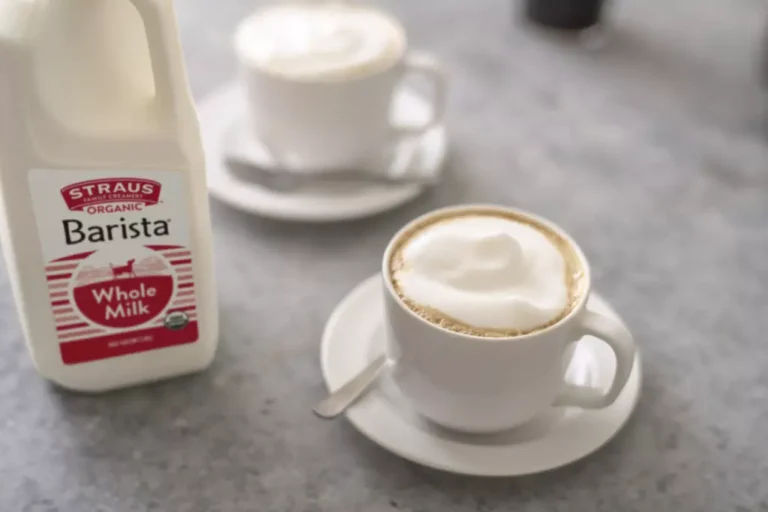How to Make Cappuccinos: A Clear and Confident Guide

If you’re a coffee lover, you’ve probably tasted a cappuccino at least once. This classic Italian drink is a popular choice for coffee drinkers all over the world. A cappuccino is made by combining espresso with steamed milk and a thick layer of milk foam on top. The result is a creamy and frothy beverage that’s perfect for any time of day.
Making a cappuccino at home may seem intimidating, but it’s actually quite simple with the right equipment and ingredients. To make a delicious cappuccino, you’ll need high-quality espresso, fresh milk, and a good frothing wand. We’ll guide you through the steps of making the perfect cappuccino, from brewing the espresso to frothing the milk and assembling the drink. Whether you’re a seasoned barista or a coffee enthusiast looking to expand your skills, we’ve got you covered.
Key Takeaways
- Making a cappuccino requires high-quality espresso, fresh milk, and a frothing wand.
- Brewing the espresso and frothing the milk are the two essential steps in making a cappuccino.
- With the right equipment and ingredients, anyone can make a delicious cappuccino at home.
Understanding Cappuccino
Cappuccino is a popular Italian coffee drink that is enjoyed all over the world. It is a delicious blend of espresso and milk foam that is usually served in a small cup. In this section, we will discuss the history of cappuccino and the differences between cappuccino, latte, and macchiato.
History of Cappuccino
The origin of cappuccino can be traced back to Italy in the early 1900s. The drink was named after the Capuchin monks who wore brown robes with hoods that resembled the color of the coffee. The first cappuccinos were made with equal parts of espresso, steamed milk, and milk foam. Over time, the recipe has evolved to include more or less milk foam depending on personal preference.
Cappuccino Vs Latte Vs Macchiato
Cappuccino, latte, and macchiato are all espresso-based drinks, but they differ in their ingredients and preparation. Here is a table that summarizes the differences between these three drinks:
| Drink | Espresso | Milk | Milk Foam |
|---|---|---|---|
| Cappuccino | 1/3 | 1/3 | 1/3 |
| Latte | 1/6 | 2/3 | 1/6 |
| Macchiato | 1/3 | – | A dollop |
As you can see from the table, cappuccino has equal parts of espresso, milk, and milk foam, while latte has more milk and less foam. Macchiato, on the other hand, has a dollop of milk foam on top of the espresso.
Another difference between these drinks is the order in which they are prepared. Cappuccino is usually made by adding the milk foam to the espresso, while latte is made by adding the steamed milk to the espresso. Macchiato, which means “stained” in Italian, is made by adding a dollop of milk foam to the espresso, which creates a “stain” on top of the drink.
In conclusion, cappuccino is a delicious coffee drink that has a rich history and is enjoyed all over the world. Understanding the differences between cappuccino, latte, and macchiato can help you choose the right drink for your taste buds.
Ingredients for Cappuccino
To make a delicious cappuccino, you need just a few simple ingredients: coffee beans and milk. Let’s take a closer look at each of these ingredients and what to look for when selecting them.
Coffee Beans
The quality of your coffee beans will greatly affect the taste of your cappuccino. We recommend using high-quality, freshly roasted coffee beans for the best flavor. Look for beans that are labeled as espresso roast, as they are specifically designed to be used in espresso-based drinks like cappuccinos.
When selecting your beans, consider the roast level. Dark roast beans will have a stronger, more intense flavor, while medium roast beans will have a more balanced flavor profile. Experiment with different roast levels to find the one that you prefer.
Milk
Milk is a crucial component of a cappuccino, as it adds both flavor and texture. While any type of milk can be used, whole milk is the traditional choice and will give you the creamiest, richest foam. However, if you prefer a lighter option, low-fat milk can also be used.
For those who are lactose intolerant or prefer a non-dairy option, oat milk is a great alternative. It has a creamy texture that is similar to whole milk and froths well.
When steaming your milk, it’s important to use cold milk and a clean, cold metal pitcher. This will help create a smooth, velvety texture and prevent the milk from scorching.

Essential Equipment
If you want to make a cappuccino that is as close to what you’d get from your local coffee shop, you’ll need some essential pieces of equipment. Here are the three main pieces of equipment you’ll need:
Espresso Machine
An espresso machine is the most important piece of equipment you’ll need to make a cappuccino. There are many types of espresso machines available, from manual espresso makers to fully automatic machines. Some of the most common types of espresso machines include:
- Manual espresso makers: These machines require you to manually pump the lever to create the pressure needed to extract the espresso.
- Semi-automatic espresso machines: These machines use an electric pump to create the pressure needed to extract the espresso.
- Fully automatic espresso machines: These machines do everything for you, from grinding the coffee beans to frothing the milk.
When choosing an espresso machine, consider factors such as ease of use, durability, and price.
Milk Frother
To create the frothy milk needed for a cappuccino, you’ll need a milk frother. There are two main types of milk frothers:
- Handheld milk frothers: These are small, battery-operated devices that you can use to froth milk in a cup or mug.
- Steam wand frothers: These are built-in devices on some espresso machines that use steam to froth milk.
When choosing a milk frother, consider factors such as ease of use, speed, and the type of milk it can froth.
Tamper
A tamper is a small device used to pack the coffee grounds into the portafilter before brewing. It ensures that the coffee is evenly distributed and packed tightly, which helps to create a consistent and flavorful shot of espresso. There are many types of tampers available, from simple plastic tampers to high-end metal tampers.
When choosing a tamper, consider factors such as size, weight, and material. A good tamper should fit comfortably in your hand and be easy to use.
With these three essential pieces of equipment, you’ll be well on your way to making delicious cappuccinos at home.
Making the Espresso
When it comes to making a cappuccino, the espresso is the foundation of the drink. Here are the key steps to making a great espresso:
Grind Size
To make a good espresso, you need to start with the right grind size. The grind size affects the rate at which water flows through the coffee, which in turn affects the flavor and strength of the espresso. For espresso, you want a fine grind that is similar in texture to table salt.
Pressure
The next step is to apply pressure to the coffee grounds. This is typically done with an espresso machine, which uses high pressure to force hot water through the coffee. The pressure should be around 9 bars, which is the standard for most espresso machines.
Pulling the Shot
To pull a shot of espresso, you’ll need to follow these steps:
- Fill the portafilter with freshly ground coffee, using a tamper to press it down evenly.
- Lock the portafilter into the group head of the espresso machine.
- Turn on the machine and wait for it to heat up.
- Place your espresso cup or shot glass under the spout.
- Press the button to start the flow of water. The shot should take around 25-30 seconds to extract.
- Stop the flow of water once you have the desired amount of espresso.
The ideal amount of espresso for a cappuccino is around 2 ounces, or 60 milliliters. The espresso should have a rich, dark color and a layer of crema on top.
Overall, making a great espresso takes practice and attention to detail. By using the right grind size, pressure, and technique, you can create a delicious base for your cappuccino.
Frothing the Milk
Frothing the milk is an essential step in making a delicious cappuccino. It involves creating microfoam, which is a creamy and velvety texture that adds a rich flavor to your drink. In this section, we will discuss the different techniques for frothing the milk, including choosing the right milk, creating microfoam, and steaming wand techniques.
Choosing the Right Milk
Choosing the right milk is crucial to achieving the perfect froth. Whole milk is the most common choice, as it has a high fat content that produces a smooth and creamy texture. However, if you are looking for a healthier option, you can use skim milk or almond milk. Keep in mind that skim milk produces less foam due to its low fat content, while almond milk can be challenging to froth due to its lack of protein.
Creating Microfoam
Creating microfoam involves introducing air into the milk, which creates small bubbles that give the milk its velvety texture. To create microfoam, you can use a frothing wand or a steam wand.
To use a frothing wand, place the wand just below the surface of the milk and turn it on. Move the wand in a circular motion to create a vortex, which will allow the milk to froth evenly. Keep frothing until you reach your desired texture.
To use a steam wand, place the wand just below the surface of the milk and turn on the steam. Hold the pitcher at a slight angle and move it up and down to create a whirlpool. This technique will help you achieve a creamy and velvety texture.
Steaming Wand Techniques
The steaming wand is a crucial tool in creating microfoam. There are different techniques you can use to froth the milk, depending on the type of drink you want to make.
For a cappuccino, you should aim for a thick and creamy foam. Start by submerging the wand just below the surface of the milk and turning on the steam. Keep the wand in the same position until the milk reaches around 100°F. Then, move the wand down to the bottom of the pitcher and continue steaming until the milk reaches around 150°F. This technique will create a thick, creamy foam that is perfect for cappuccinos.
For a latte, you should aim for a thinner foam. Start by submerging the wand just below the surface of the milk and turning on the steam. Move the wand up and down to create a whirlpool and distribute the heat evenly. Stop steaming when the milk reaches around 150°F. This technique will create a thin and silky foam that is perfect for lattes.
In conclusion, frothing the milk is an essential step in making a delicious cappuccino. By choosing the right milk, creating microfoam, and using the right steaming wand techniques, you can achieve a creamy and velvety texture that will take your cappuccino to the next level.
Assembling the Cappuccino
Once you have pulled the espresso shots and frothed the milk, it’s time to assemble your cappuccino. Here’s how to do it:
Pouring the Espresso
First, grab your mug and pour the espresso shot(s) into it. We recommend using a 6-8 ounce mug for a single shot and a 12 ounce mug for a double shot. If you want to add any additional flavorings, such as syrup or chocolate, now is the time to do so. Simply add the desired amount to the espresso and stir well.
Adding the Frothed Milk
Next, it’s time to add the frothed milk. Hold the frothing pitcher at a slight angle and pour the milk into the mug, aiming for the center of the espresso. As you pour, slowly tilt the pitcher upright so that the milk and foam mix together. We recommend using a spoon to hold back the foam and pour the milk first, then spooning the foam on top.
Finishing Touches
To finish off your cappuccino, sprinkle a dusting of cocoa powder on top of the foam. You can also use a stencil to create a fun design. If you want a sweeter cappuccino, you can add a sprinkle of sugar or drizzle of syrup on top as well.
And just like that, you have a delicious cappuccino ready to enjoy! If you’re feeling extra fancy, you can serve it with a biscotti or other sweet treat on the side.
At the end of the day, the key to a great cappuccino is using high-quality ingredients and mastering the art of frothing milk. We recommend using a high-quality espresso, such as Illy, and practicing your milk frothing technique until you get it just right. With a little practice, you’ll be making barista-quality cappuccinos in no time.
Alternative Methods
If you don’t have an espresso machine at home, don’t worry! You can still make a delicious cappuccino using alternative methods. Here are a few options to consider:
Using a French Press
A French press can be a great tool to make espresso-like coffee at home. Here’s how to make a cappuccino using a French press:
- Grind your coffee beans to a fine consistency.
- Add the ground coffee to the French press.
- Heat up milk in a microwave or on the stove.
- Use a whisk to froth the milk until it’s light and fluffy.
- Pour the espresso into a cup.
- Add the frothed milk on top of the espresso.
Using an Aeropress
An Aeropress is another great option for making espresso-like coffee at home. Here’s how to make a cappuccino using an Aeropress:
- Grind your coffee beans to a fine consistency.
- Add the ground coffee to the Aeropress.
- Heat up milk in a microwave or on the stove.
- Use a whisk to froth the milk until it’s light and fluffy.
- Brew the espresso using the Aeropress.
- Pour the espresso into a cup.
- Add the frothed milk on top of the espresso.
Making an Iced Cappuccino
If you’re in the mood for a refreshing iced cappuccino, here’s how to make one at home:
- Brew a cup of strong coffee using a French press or Aeropress.
- Add sugar or sweetener, if desired.
- Let the coffee cool down in the refrigerator for at least 30 minutes.
- Fill a glass with ice.
- Pour the cooled coffee into the glass.
- Heat up milk in a microwave or on the stove.
- Use a whisk to froth the milk until it’s light and fluffy.
- Pour the frothed milk on top of the iced coffee.
With these alternative methods, you can enjoy a delicious cappuccino at home without an expensive espresso machine.
Nutritional Information
When it comes to cappuccinos, the nutritional information can vary widely depending on the ingredients used and the size of the drink. Let’s take a closer look at the basic nutritional facts of a cappuccino made with a single shot of espresso and 2 ounces of steamed milk:
| Nutrient | Amount |
|---|---|
| Calories | 64 |
| Fat | 3.5g |
| Saturated Fat | 2g |
| Cholesterol | 20mg |
| Sodium | 55mg |
| Carbohydrates | 5g |
| Fiber | 0g |
| Sugars | 5g |
| Protein | 3g |
As you can see, cappuccinos are relatively low in calories and carbohydrates, but can be higher in fat and sugar depending on the type of milk and any added sweeteners. If you are watching your calorie or sugar intake, it may be best to stick to a smaller size or opt for a sugar-free syrup.
One thing to keep in mind is that cappuccinos can be a good source of protein if made with whole milk. A single 8-ounce serving of whole milk contains around 8 grams of protein, which can help keep you feeling full and satisfied for longer. However, if you are lactose intolerant or following a vegan diet, you may want to opt for a non-dairy milk alternative such as almond or soy milk.
Overall, cappuccinos can be a tasty and satisfying treat, but it’s important to be mindful of the nutritional information and ingredients used. By choosing lower-fat milk and avoiding added sugars, you can enjoy a delicious cappuccino without derailing your healthy eating habits.
Cappuccinos in Coffee Shops
At coffee shops, cappuccinos are one of the most popular drinks on the menu. They are made with espresso, steamed milk, and milk foam, and are often served in a small cup. In this section, we’ll explore the techniques that baristas use to make the perfect cappuccino, and help you understand the coffee shop menu.
Barista Techniques
Baristas are highly skilled professionals who are trained to make a variety of coffee drinks, including cappuccinos. To make a cappuccino, a barista will start by pulling a shot of espresso. They will then steam and froth the milk, using an electric mixer or steam wand to create a velvety texture. Once the milk is ready, the barista will pour it over the espresso, leaving a layer of foam on top.
One of the key techniques that baristas use when making cappuccinos is to get the milk temperature just right. If the milk is too hot, it can scorch the espresso and ruin the flavor. If it’s not hot enough, the drink will be cold and unappetizing. Baristas also pay close attention to the milk-to-espresso ratio, ensuring that each cappuccino is perfectly balanced.
Understanding the Coffee Shop Menu
When you visit a coffee shop, you’ll often find a wide variety of drinks on the menu. Some of these drinks might be familiar to you, while others might be new and exciting. If you’re not sure what to order, don’t be afraid to ask the barista for recommendations.
When it comes to cappuccinos, you’ll usually have a few options to choose from. Some coffee shops offer flavored cappuccinos, which are made with syrups or other additives. Others might offer different milk options, such as almond or soy milk. If you’re looking for a classic cappuccino, be sure to ask for one made with whole milk.
It’s also worth noting that some coffee shops might have different names for their cappuccinos. For example, a “wet cappuccino” might have more milk than foam, while a “dry cappuccino” might have more foam than milk. If you’re not sure what a particular drink is, don’t hesitate to ask the barista for more information.
Overall, cappuccinos are a delicious and satisfying coffee drink that can be enjoyed at any time of day. Whether you’re a seasoned coffee drinker or a newcomer to the world of coffee, a cappuccino is a great choice for anyone looking for a rich and flavorful coffee experience.






One Comment